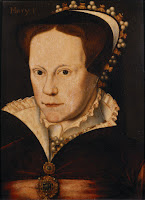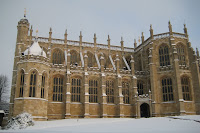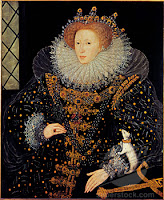by Barbara Kyle
 Research is the lifeblood of our art. Ask any historical novelist and they'll tell you that poring over the letters and diaries of our subjects and reading biographies of them and books about their times is a hugely engrossing part of our work. So engrossing, in fact, that I don't think of it anymore as "research." To me it's THE Search.
Research is the lifeblood of our art. Ask any historical novelist and they'll tell you that poring over the letters and diaries of our subjects and reading biographies of them and books about their times is a hugely engrossing part of our work. So engrossing, in fact, that I don't think of it anymore as "research." To me it's THE Search.It's like panning for gold. I sit by the riverside day after day sifting through mounds of information sand. Every grain is worth scanning, because I'll need these stolid, solid facts to ground my stories in the truth of the period, but they're not eye-catching. It's the nuggets I look for. The details that gleam, the facets that will spark my subject to flesh-and-blood life.
I'd like to share with you three such nuggets that have sparked the life of my books.
 |
| Sir Thomas More |
My research revealed that in 1517 More was undersheriff of London, and that on May 1st of that year the London apprentices rioted and he went with a troop of guards to speak to them. The young men were a furious mob, their torches flaring in the night as they went on a rampage, denouncing foreigners for taking their jobs, breaking into foreign-owned shops, and assaulting Italians and Flemings in the streets.
The Nugget: Gleaming at me in my research was the fact that, years after More's death, Shakespeare had a hand, along with others, in collaboratively writing a play called "Sir Thomas More." I went to the British Museum and read the original manuscript. It gave me goose bumps.
Shakespeare's brilliance glitters in every line he wrote. There's a scene of the May Day riot in which More, as undersheriff, addresses the furious apprentices and shames them by asking how would they feel if they were friendless in a faraway county where they would be the foreigners. Would they not hope to be treated with compassion?
 |
| William Shakespeare |
"For other ruffians, as their fancies wrought,
With self same hand, self reasons, and self right,
Would shark on you, and men like ravenous fishes
Would feed on one another."
He points out an apprentice whose kind Italian master is giving him a good livelihood and a secure future. With this tolerant rationale More calms the mob. The event is so stirring I used it, incorporating my created characters, as the opening of The Queen's Lady.
My second novel, The King's Daughter, features Isabel Thornleigh, Honor's daughter, who joins the uprising led by Sir Thomas Wyatt, a true event in which the rebels sought to unseat Mary I from the throne in the winter of 1554. The only surviving child of Henry VIII and his pious first wife, Catherine of Aragon, Mary was driven by religious zeal. As queen she oversaw the burning of hundreds of English men and women, earning the name her subjects gave her in her lifetime: Bloody Mary.
 |
| Mary I |
 The Nugget. I read J.J. Scarisbrick's monumental biography, Henry VIII, in which he reports that, for decades after Mary’s reign, there was "whispering" that she had dug up the entombed remains of her royal father and burned him as a heretic. Again, I got goose bumps. I can use that, I thought. And I did. The King's Daughter opens on a snowy night at Windsor Castle where, inside St. George’s Chapel, Mary orders the gravedigger to smash the tomb with his pickaxe. And then she burns her hated father's bones.
The Nugget. I read J.J. Scarisbrick's monumental biography, Henry VIII, in which he reports that, for decades after Mary’s reign, there was "whispering" that she had dug up the entombed remains of her royal father and burned him as a heretic. Again, I got goose bumps. I can use that, I thought. And I did. The King's Daughter opens on a snowy night at Windsor Castle where, inside St. George’s Chapel, Mary orders the gravedigger to smash the tomb with his pickaxe. And then she burns her hated father's bones.Mary's five years as queen were a disaster. She unleashed religious strife, plunged her realm into bankruptcy to finance the wars of her husband, Philip of Spain, and forfeited Calais, England's last precious toehold in Europe.
 |
| Philip and Mary |
Yet it is hard not to pity the woman when we consider what she suffered. She adored Philip, who spent only enough time with her to perform his conjugal duty before returning to Spain. A few months later Mary joyfully announced she was pregnant, good news for her people who were anxious to one day have a king. Mary happily passed the next months employing her gentlewomen to sew baby clothes, installing midwives, and sending ecstatic notices to every head of state about the imminent birth.
The Nugget. This is a sad one. Mary's time came to deliver . . . and passed. There was no baby. Hers was a phantom pregnancy. Court gossip raged as she remained holed up in her private rooms, and foreign ambassadors wrote home about the situation with increasing astonishment as Mary willed herself to believe she really was pregnant right through the tenth month. (Some modern scholars have attributed her malady to uterine cancer.) This event became a pivotal one in my novel.
 |
| Elizabeth I |
The Queen's Gamble is set in the first year of Elizabeth's reign when her future triumphs were still undreamed of. Quite the contrary: she was just twenty-four and without allies, since all of Catholic Europe considered her a bastard and a heretic. She and her council feared that France would invade via Scotland, a country France controlled. People throughout Europe were laying bets that Elizabeth's reign would not last the year.
In my novel Isabel Thornleigh returns from the New World to find French troops posted on the English border, ostensibly to crush Scottish rebels who have banded together under the firebrand preacher John Knox to oust the French. But everyone believes that once the French defeat Knox they will then invade England.

The Nugget. My research told me that Elizabeth, though desperate for Knox's rebels to win, did not dare openly send them aid for fear it would provoke the very attack from France that she was trying to prevent. So she sent the gold secretly, via a gentleman of her court. It was stolen en route, and Knox had to struggle on with his campaign until Elizabeth eventually sent troops to help him.
All fiction springs from a "What if?" question in the author's mind, and I took that glinting nugget of the stolen gold and polished it. It became the driving plot element in The Queen's Gamble: Isabel goes north to Scotland with the Queen's gold while war brews all around her.
My new novel, Blood Between Queens, features cousins Elizabeth I of England and Mary, Queen of Scots, locked in their deadly rivalry for the English crown. Nuggets guaranteed.
~~~~~~~~~~~~~
Barbara Kyle is the author of the acclaimed "Thornleigh" novels The Queen’s Gamble, The Queen’s Captive, The King’s Daughter and The Queen’s Lady, all published internationally, and the upcoming Blood Between Queens (May 2013). The "Thornleigh" novels follow a rising middle-class English family through three turbulent Tudor reigns.
Visit www.BarbaraKyle.com and follow Barbara on Twitter @BKyleAuthor.

Aren't these nuggets wonderful? I love to just read history books in case I come up with a nugget here and there - and I have found a "what if" that I will use some time. The play about Thomas More is in the Riverside Shakespeare, which also contains The Two Noble Kinsmen. I bought that years ago when I was at uni, not sure if it's still in print, but you don't need to go looking at dusty archives to get it.
ReplyDeleteGo for that "what if" idea, Sue! Consulting the dusty archive was worth the effort in this case, because Shakespeare's work on the play "Sir Thomas More" is one of the very few examples we have of his handwriting, an exciting thing to behold.
DeleteGood post. Gripping stuff!
ReplyDeleteGlad you enjoyed it, Tim!
DeleteFrom down here shoveling out the ditch, it is grand watching what them lord and ladies be up to in the high house. Imagine being that clean and perfumed in a smelly way. Can't wait for my Boxing Day box of vittles and a bottle of plonk off ol' Master's table. Me n' the wench will feast and roll in the mud for sure, just to stays warm.
ReplyDeleteHa! Enjoy the roll, Peter!
DeleteThis whole post was a fascinating nugget in itself! I can't wait to come across one myself; just glimmering little pebbles so far.
ReplyDeleteLooking forward to reading Blood Between Queens. I hope everything is going smoothly as the release day approaches!
I look forward to seeing the gold you give us, Svea - and thanks for your kind words as the launch of Blood Between Queens draws nigh!
ReplyDeleteBarbara-
ReplyDeleteI agree, I love The Search -- in fact I live for it. When researching I keep Post-Its and 3 x 5 cards on-hand and every time I come across a “nugget” I make a note on where it could possibly be placed in the story. In my opinion, uncovering these “nuggets” is one of the most thrilling things about writing historical fiction. It is like being on a treasure hunt and finding the next clue, and oh…where will this next “nugget” take us on our grand adventure of writing? I thoroughly enjoyed your post, thank you for letting us into your process. I see how you use in each of your novels a historic “nugget” spinning the tale off from it, using it as your beginning point of drama that lures and carries the reader into the body of the story. Brilliant craft.
Regards,
Stephanie Renée dos Santos
www.stephaniereneedossantos.com
I can "hear" your excitement for the craft in your words, Stephanie. It's a grand thing, isn't it?
DeleteOhhh I so eagerly awaiting my copies of the rest of the Thornleigh Seies. I am not sure when I will get them but I so eager to know what happens next. So exciting, whewwwww! Reading is fun, sometimes it is not researching, it is reading. Especially if it is juicy.
ReplyDeleteI'm delighted that you've enjoyed the adventures of the Thornleigh family, and they continue in Blood Between Queens, which will be out in May, so happy reading!
ReplyDeleteHi Barbara,
ReplyDeleteI really enjoyed reading about the "nuggets" you uncovered. You made researching sound fun.
Congratulations on another published novel. Woot!
Tracy :-)